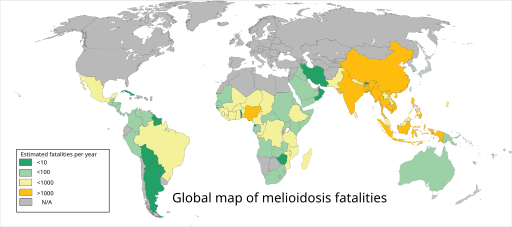Melioidosis is a deadly tropical disease that flies under the radar. Around 150-200 thousand people get it every year, and more than half of people diagnosed die. One of the largest problems of this disease is that it takes several days to diagnose, meaning it takes several days for patients to receive the correct treatments. However, a new test, using CRISPR, could change that.
A new test has been invented that uses CRISPR to detect a genetic target that is specific to Burkholderia pseudomallei, which is the bacteria that causes meliondosis. The new test can detect the gene with almost a 94% sensitivity. It was developed by researchers at the Mahidol-Oxford Tropical Medicine Research Unit, Chiang Mai University, Vidyasirimedhi Institute of Science and Technology in Thailand, and the Wellcome Sanger Institute in the UK. The results of this new CRISPR test mean that thousands of people could be saved annually from meliondosis, with an easy to use rapid test.
The disease is caused by Burkholderia pseudomallei, which is found in water and soil of sub tropical and tropical regions. It enters the body through cuts on the skin, ingestion, or inhalation. One of the reasons it’s difficult to diagnose is that the symptoms range from pneumonia to those of a chronic infection. This, paired with the fact its more common in rural areas, causes this disease to be under reported.
Currently, melioidosis is diagnosed in patients after bacterial samples are cultured, which takes three to four days. But, in Thailand, 40% of patients die after just a couple days while waiting for the tests to come back. Currently, there is no vaccine for this disease, but it can be treated with an antibiotic such as carbapenem. However, due to the range of the symptoms, many other and or wrong antibiotics are prescribed, which wastes time and money.
To develop a new test, researchers identified a genetic target specific to B. pseudomallei by analyzing over 3,000 B. pseudomalleigenomes. Their new test called CRISPR-BP34, ruptures bacterial cells and using a recombinase polymerase amplification reaction to amplify the bacterial target DNA for increased sensitivity. In addition to this, a CRISPR reaction is used to provide specifics. The researchers collected samples from about 100 people with the disease and 200 without, in order to test the legitimacy of the test. The new test got results in just four hours and enhanced the sensitivity from about 66% to almost 94%.
This relates to our study of the immune system in AP Biology. As we’ve learned in Biology, first macrophages and neutrophils are the first responders, and they attempt to engulf and destroy the disease. The helper T-cells try and coordinate the response while killer T-cells are attempting to destroy the disease. And cytokines signal molecules to come help defeat the disease. While these attempts by our body is unsuccessful more often than not, it still displays the immune system response learned in AP Biology.
This new test will help save thousands of lives by making diagnoses faster, which will allow the correct treatment to be given in hours, instead of days. This is truly a groundbreaking invention.
Where else do you think CRISPR can be used?
Had you ever heard of Melioidosis before?
Why do you think there is such a large range of symptoms for Melioidosis?


Leave a Reply